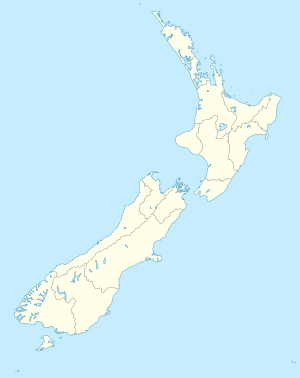Atiamuri power plant
| Atiamuri Power Station | ||
|---|---|---|
| The power plant's machine house | ||
| location | ||
|
|
||
| Coordinates | 38 ° 23 ′ 31 ″ S , 176 ° 1 ′ 19 ″ E | |
| country |
|
|
| place | Waikato region | |
| Waters | Waikato River | |
| power plant | ||
| owner | Mercury NZ Limited | |
| operator | Mercury NZ Limited | |
| Start of planning | 1949 | |
| construction time | 1953 to 1958 | |
| Start of operation | 1958 | |
| technology | ||
| Bottleneck performance | 84 megawatts | |
| Standard work capacity | 305 million kWh / year | |
| Turbines | Francis turbines 4 × 22 MW | |
| Generators | 4 × 21 MW | |
| Others | ||
| Website | www.mercury.co.nz | |
The power plant Atiamuri ( Atiamuri Power Station ) is a hydropower plant on the North Island of New Zealand .
Origin of name
“ A-Tia-Muri ” literally means “turned around” in the Māori language and refers to the exploration of the Tia of the Arawa canoe . The intrepid traveler had to turn around at the Atiamuri rapids during his early explorations of the Waikato River . Legend also has it that Tia was petrified into a large stone in the rapids.
geography
The Atiamuri Power Station is the third power plant in a chain of eight hydropower plants on the Waikato River . The power plant is located 32 km north-northwest of the city of Taupo and can be reached from New Zealand State Highway 1, which runs 300 m to the south .
history
In 1949, the then New Zealand government began planning the Atiamuri power plant together with the Ohakuri and Waipapa power plants . Work on the dam began in November 1953 and exactly five years later the power plant was able to go into operation and generate its first electricity. Initially designed for three generators that went into operation one after the other in November 1958, December 1958 and May 1959, the fourth generator was later installed in April 1962.
As of 2020, the power plant will be operated by the majority state-owned company Mercury NZ Limited , formerly Mighty River Power .
Barrier structure
The barrier structure consists of a gravity dam made of earth on the southeast side and a gravity dam made of concrete, below which the power plant is also located, on the northwest side. For the concrete dam, which has a length of 171 m and a height of 44 m, a total of 118,000 m³ of concrete was used, whereas the earth dam, which extends over a length of 266 m and is 31 m high, has a volume of 321,000 m³. The earth dam has a width of 152 m at its base and a width of 7 m at its crown. The concrete dam, on the other hand, has a width of 38 m at its base and tapers at the top to 7.3 m. In order to minimize the seepage of water and to reinforce the foundations of the dam wall 12 m deep in the original river bed, extensive injections of the surrounding rock were necessary.
power plant
The Atiamuri Power Station has an installed capacity of 84 MW and an average annual electricity generation of around 305 GWh . The four generators driven by Francis turbines are designed for an output of 21 MW each.
Reservoir
With the completion of the barrier structure, the water of the Waikato River to Lake Atiamuri was dammed. The lake, which extends over an area of 2.2 to 2.4 km², has a usable volume of 4.5 million m³ of water for power generation with a variable storage target of 249.07 m to 253.09 m
See also
Web links
Individual evidence
- ↑ a b 04. Atiamuri - Overview . Mighty River Power , archived from the original on June 10, 2011 ; accessed on January 6, 2020 (English, original website no longer available).
- ↑ Topo maps . Land Information New Zealand , accessed January 6, 2020 .
- ↑ a b 04. Atiamuri - Technical . Mighty River Power , archived from the original on June 10, 2011 ; accessed on January 6, 2020 (English, original website no longer available).
- ↑ Hydro Generation . Mercury NZ Limited , accessed January 6, 2020 .
- ↑ a b c STATEMENT OF EVIDENCE OF FRASER SCOTT WHINERAY. (PDF 2.3 MB) Waikato Regional Council, pp. 8-10, 19-20, 24 , archived from the original on January 26, 2015 ; accessed on June 26, 2015 (English, original website no longer available).
- ^ Waikato Lake Levels . Mercury NZ Limited , accessed January 4, 2020 .

